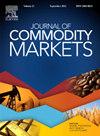Media emotion intensity and commodity futures pricing
IF 4.5
4区 经济学
Q1 BUSINESS, FINANCE
引用次数: 0
Abstract
This study investigates the impact of media emotion intensity on commodities futures returns. Emotion intensity measures the proportion of emotional content relative to factual content in media news. The media emotion intensity factor generates an annual premium of 13% after transaction cost. This premium is more pronounced for commodities with low media coverage, high momentum, high basis-momentum, high hedging pressure, and backwardation. Emotion intensity significantly predicts the trading tendencies of both commercial and non-commercial traders and the cross-section of commodity futures returns at both portfolio and individual levels. We also find that media emotion intensity predicts future commodities’ sentiment. Further, other commonly considered risk sources cannot subsume the predictability of the media emotion intensity factor.
媒体情绪强度与商品期货定价
本研究探讨媒体情绪强度对商品期货收益的影响。情感强度衡量媒体新闻中情感内容相对于事实内容的比例。媒体情感强度因素扣除交易成本后产生的年溢价为13%。这种溢价在低媒体报道、高动量、高基本动量、高对冲压力和现货溢价的商品中更为明显。情绪强度对商业交易者和非商业交易者的交易趋势以及商品期货在投资组合和个人层面上的收益横截面都有显著的预测作用。我们也发现媒体情绪强度预测未来商品情绪。此外,其他通常认为的风险源不能包含媒体情绪强度因素的可预测性。
本文章由计算机程序翻译,如有差异,请以英文原文为准。
求助全文
约1分钟内获得全文
求助全文
来源期刊

Journal of Commodity Markets
Multiple-
CiteScore
5.70
自引率
2.40%
发文量
53
期刊介绍:
The purpose of the journal is also to stimulate international dialog among academics, industry participants, traders, investors, and policymakers with mutual interests in commodity markets. The mandate for the journal is to present ongoing work within commodity economics and finance. Topics can be related to financialization of commodity markets; pricing, hedging, and risk analysis of commodity derivatives; risk premia in commodity markets; real option analysis for commodity project investment and production; portfolio allocation including commodities; forecasting in commodity markets; corporate finance for commodity-exposed corporations; econometric/statistical analysis of commodity markets; organization of commodity markets; regulation of commodity markets; local and global commodity trading; and commodity supply chains. Commodity markets in this context are energy markets (including renewables), metal markets, mineral markets, agricultural markets, livestock and fish markets, markets for weather derivatives, emission markets, shipping markets, water, and related markets. This interdisciplinary and trans-disciplinary journal will cover all commodity markets and is thus relevant for a broad audience. Commodity markets are not only of academic interest but also highly relevant for many practitioners, including asset managers, industrial managers, investment bankers, risk managers, and also policymakers in governments, central banks, and supranational institutions.
 求助内容:
求助内容: 应助结果提醒方式:
应助结果提醒方式:


